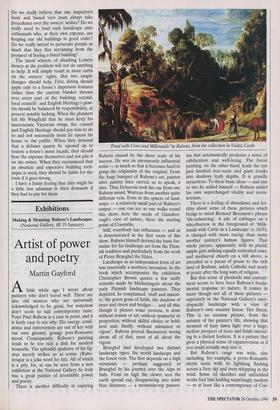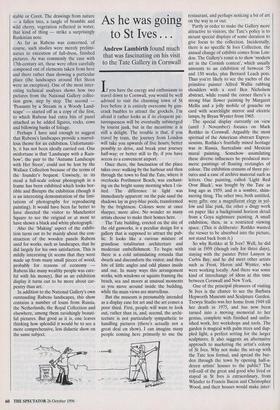Exhibitions
Making & Meaning: Rubens's Landscapes (National Gallery, till 19 January)
Artist of power and poetry
Martin Gayford
Alittle while ago I wrote about painters who don't travel well. There are also old masters who are universally acknowledged to be great, but somehow don't seem to suit contemporary taste. Peter Paul Rubens is a case in point, and it is fairly easy to see why. His energy, confi- dence and extroversion are out of key with our own gloomy, grungy post-Romantic mood. Consequently, Rubens's painting tends to be too rich a dish for modern stomachs. The splendid opulence of his fig- ures merely strikes us as comic (Rube- nesque is a joke word for fat). All of which is a pity, for, as can be seen from a new exhibition at the National Gallery he truly was a great painter of irresistible power and poetry. There is another difficulty in enjoying Pond with Cows and Milkmaids' by Rubens, from the collection in Vaduz Castle Rubens caused by the sheer scale of his success. He was an enormously influential artist — so much so that it becomes hard to grasp the originality of the original. From the huge banquet of Rubens's art, painter after painter later carved, so to speak, a slice. Thus Delacroix took his cue from one Rubens mood, Watteau from another quite different vein. Even in the sphere of land- scape — a relatively small part of Rubens's output one can see as one walks round this show, here the seeds of Gainsbor- ough's view of nature, there the starting point of Constable.
Still, everybody has influences — and as is demonstrated in the first room of this show, Rubens himself derived the basic for- mulae for his landscape art from the Flem- ish tradition and particularly from the work of Pieter Brueghel the Elder.
Landscape as an independent form of art was essentially a northern invention. In the book which accompanies the exhibition Christopher Brown quotes a few sniffy remarks made by Michelangelo about the early Flemish landscape painters. They depicted, he complained, 'stuff and mason- ry, the green grass of fields, the shadows of trees and rivers and bridges ... and all this, though it pleases some persons, is done without reason or art, without symmetry or proportion, without skilful choice or bold- ness and, finally, without substance or vigour'. Rubens proved Buonarroti wrong about all of that, most of all about the vigour.
Brueghel had developed two distinct landscape types: the world landscape and - the forest view. The first depends on a high viewpoint — perhaps suggested to Brueghel by his journey over the Alps to Italy. From on high the viewer sees the earth spread out, disappearing into misty blue distances — a mountain-top panora- ma that automatically produces a sense of exhilaration and well-being. The forest painting, on the other hand, leads the eye past knotted tree-roots and giant trunks into shadowy leafy depths. It is grandly mysterious. To these basic ideas — and one or two he added himself — Rubens added his own supercharged vitality and inven- tiveness.
There is a feeling of abundance and fer- tility about some of these pictures which brings to mind Bernard Berenson's phrase `life-enhancing'. A pile of cabbages on a wheelbarrow in the foreground of 'Milk- maids with Cattle in a Landscape' (c.1618), is charged with more energy than many another painter's human figures. That whole picture, apparently, with its placid, ample girls milking equally contented cows, and mediaeval church on a hill above, is intended as a paean of praise to the rich land of Brabant, safely Catholic and newly at peace after the long wars of religion.
But that sense of plenitude and content- ment seems to have been Rubens's funda- mental response to nature. It comes in many though not all of these pictures supremely in the National Gallery's ency- clopaedic landscape with a view of Rubens's own country house, Het Steen. This is an autumn picture, from the autumn of the painter's life, showing that moment of hazy dawn light over a huge, mellow prospect of trees and fields extend- ing to a distant horizon. It is a picture that gives a physical sense of expansiveness as if you could actually step into it.
But Rubens's range was wide, also including, for example, a proto-Romantic storm scene with its lightning flashing across a fiery sky and trees whipping in the wind. Some oil sketches and unfinished works find him looking surprisingly modern — or at least like a contemporary of Con- stable or Corot. The drawings from nature — a fallen tree, a tangle of bramble and wild cherry, vegetation reflected in water, that kind of thing — strike a surprisingly Ruskinian note.
As far as Rubens was concerned, of course, such studies were merely prelimi- naries to execution of full-dress, finished pictures. As was commonly the case with 17th-century art, these were often carefully composed out of elements taken from here and there rather than showing a particular place (the landscapes around Het Steen were an exception). One of the most inter- esting technical analyses shows how two pictures from the National Gallery collec- tion grew, step by step. The second 'Peasants by a Stream in a Woody Land- scape' — started off as a copy of the first, to which Rubens had extra bits of panel attached as he added figures, rocks, cows and billowing banks of foliage.
Perhaps I have said enough to suggest that Rubens's landscapes provide a marvel- lous theme for an exhibition. Unfortunate- ly, it has not been ideally carried out. One misfortune is that 'Landscape with a Rain- bow', the pair to the 'Autumn Landscape with Het Steen', could not be lent by the Wallace Collection because of the terms of the founder's bequest. Unwisely, in its stead a full-scale colour photograph in a frame has been exhibited which looks hor- rible and disrupts the exhibition (though it is an interesting demonstration of the limi- tations of photography for reproducing painting). It would have been far better to have directed the visitor to Manchester Square to see the original or at most to have shown a black and white photograph.
Also the 'Making' aspect of the exhibi- tion turns out to be mainly about the con- struction of the wooden panels Rubens used for works, such as landscapes, that he did largely for his own satisfaction. This is mildly interesting (it seems that they were made up from many small pieces of wood, probably for reasons of economy Rubens like many wealthy people was care- ful with his money). But as an exhibition display it turns out to be more about car- pentry than art.
In addition to the National Gallery's own outstanding Rubens landscapes, this show contains a number of loans from Russia, the Netherlands, the Royal Collection and elsewhere, among them ravishingly beauti- ful pictures. But good as it is, one leaves thinking how splendid it would be to see a more comprehensive, less didactic show on the same subject.



















































































 Previous page
Previous page